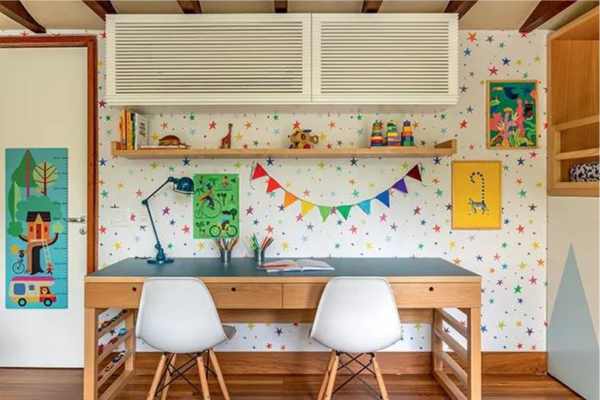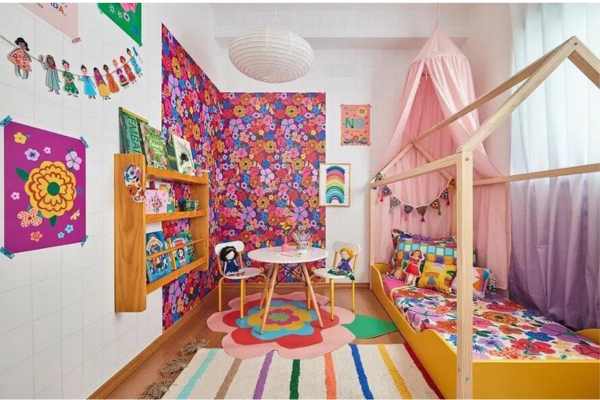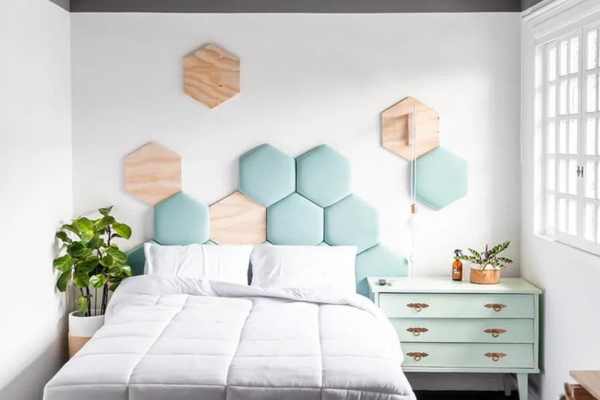Stimulating creativity and learning from an early age is crucial for the development of children’s cognitive and artistic skills.
In this guide, we will explore the idea of creating a special corner for studies and arts in children’s rooms, involving them in the decoration project.
This approach not only provides an environment conducive to learning but also strengthens the bond between parents and children, creating together a unique and personalized space.
1. Family Planning: Choosing Colors and Themes
Initiate the project with a family meeting to discuss the child’s preferences. Choose together colors, themes, and decorative elements that represent the child’s specific tastes and interests.
DIY: Inspiration Board
Create an inspiration board with magazine cutouts, color samples, and drawings, forming a visual reference for the project. This helps the child visualize the end result.
2. Functional Furniture: Practicality with Style
Choose furniture that is functional and adjustable as the child grows. Tables and chairs with adjustable heights provide comfort during studies, while shelves and organizers keep materials within reach.
DIY: Material Organizer
Create together a material organizer using decorated glass jars. This makes it easy to access pencils, brushes, and other items needed for artistic activities.
3. Reading Nook: Stimulating Imagination
Include a dedicated space for reading, with bookshelves and comfortable cushions. This not only encourages the habit of reading but also provides a quiet environment for moments of imagination.
DIY: Personalized Cushions
Transform simple cushions into personalized ones with colorful fabrics, stickers, or even painting. Create a cozy environment for the child to get lost in books.
4. Creative Chalkboard: Fun Learning
Incorporate a chalkboard wall or board to stimulate creativity. Children can draw, write, and even solve math problems interactively.
DIY: Chalkboard Wall
Turn a wall into a chalkboard area using matte black paint. Make sure to have colored chalk to bring the space to life.
5. Proper Lighting: Focus and Visual Comfort
Ensure that the environment is well-lit to avoid visual fatigue. Adjustable lamps and LED lights are ideal choices to provide proper lighting for the study area.
DIY: Customized Lamp
Personalize a simple lamp with paints, stickers, or even fabrics. This not only adds a personal touch but also creates a pleasant atmosphere.
6. Variety of Materials: Stimulating Creativity
Stock the corner with a variety of materials for arts and studies. Colored papers, paints, colored pencils, modeling clay, and other essential items should be easily accessible.
DIY: Creative Material Organizer
Create together a recyclable material organizer using decorated boxes and jars. This not only keeps everything organized but also adds an artistic touch to the space.
7. Wall Customization: Showcasing Art
Encourage the child to create their own art to display on the walls. Simple frames can turn the child’s drawings and paintings into true works of art.
DIY: Personalized Frames
Decorate simple frames with paints, glitter, or stickers. This provides a unique way to display the child’s creations.

8. Fun Family Activities: Stimulating Creativity
In addition to the decoration project, involve the child in fun family artistic activities. Here are some suggestions:
Family Painting: Plan an afternoon of painting, with each family member creating their unique artwork. Display the creations in the study corner.
Building Models: Develop projects together, such as building models to represent scenes from favorite books or imaginary places.
Group Reading Sessions: Establish a regular schedule for group reading sessions, where everyone shares their favorite stories.
Sculpture Challenges: Use playdough or clay to create thematic sculptures as a family. This promotes imagination and motor skills.
Keep reading our articles:
DIY: Fun Projects to Involve Them in Decorating Their Own Room
Setting Up a Corner for Art and Studies
Conclusion: A Space for Learning and Expression
By involving the child in the creation of a corner for studies and arts, we not only create a functional space but also promote an environment that reflects their personality and stimulates their creativity.
Active participation in this process not only strengthens family bonds but also cultivates a lasting love for learning and artistic expression. Each stroke, color, and choice in the room tells a unique story, making the space truly special.
FAQ: Creating a Study and Art Space in Children’s Rooms
1. Why is it important to involve children in creating a study and art space?
Involving children in the decoration process stimulates their creativity, allows them to express their personality, and strengthens family bonds. It also creates an environment where they feel comfortable and motivated to learn and explore their artistic skills.
2. What are the best colors and themes for a study and art corner?
The best colors and themes are those that reflect the child’s interests and preferences. That’s why it’s important to have a family meeting to discuss and choose vibrant colors, fun themes, or elements that represent the child’s hobbies and passions together.
3. How can I ensure the space is functional as the child grows?
Choosing adjustable furniture, such as tables and chairs with adjustable heights, is key. Additionally, flexible shelves and organizers help keep the space organized and adaptable to the child’s changing needs over time.
4. What is the importance of a reading nook in a child’s room?
A reading nook stimulates imagination and fosters the habit of reading from an early age. It provides a quiet space where the child can focus on books, developing their language skills and love for reading.
5. How can I create a well-lit environment to avoid visual fatigue?
Ensuring proper lighting in the study and art space is essential. Adjustable lamps and LED lights are ideal for providing the right amount of light, preventing visual fatigue, and creating a pleasant environment for the child to focus on their activities.
Personalizing lamps with the child’s help also adds a personal touch to the space.


